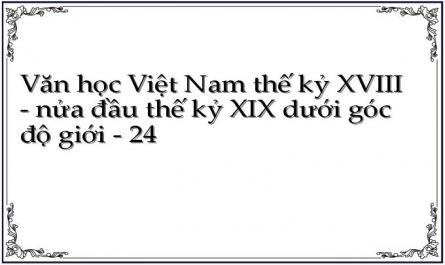174. R.W. Connell, James W. Messerschmidt (2005), “Hegemonic Masculinity: Rethinking the Concept”, Gender and Society, Vol 19, Issue 6, pp.829 – 859.
175. Demetrakis Z. Demetriou (2001), “Connell's Concept of Hegemonic Masculinity: A Critique”, Theory and Society, Vol. 30, No. 3 (Jun., 2001), pp. 337-361.
176. Olga Dror (2007) Cult, Culture, and Authority – Princess Lieu Hanh in Vietnamese History, University of Hawaii Press.
177. Wendy N. Duong (2001), “Gender Equality and Women's Issues in Vietnam: The Vietnamese Woman - Warrior and Poet”, Pacific Rim Law & Policy Journal Association, Vol.10, No.2.
178. Mary H. Fong (1996), “Images of women in Chinese Painting”, Woman‘s Art Journal, Vol. 17, No. 1, pp. 22-27.
179. Song Geng, (2004), The Fragile Scholar: Power and Masculinity in Chinese Culture. University of Washington Press.
180. Elizabeth D. Harvey (1995), Ventriloquized Voice: Feminist Theory and English Renaissance Texts, Routledge.
181. Richard C. Hessney, Robert E. Hegel, (1985), Expression of self in Chinese literature, Columbia University Press, New York.
182. Brooke Holmes (2012), Gender: Antiquity and Its Legacy, Oxford University Press.
183. Martin W. Huang, (1995), Literati and self-re/presentation: autobiographical sensibility in the eighteenth-century Chinese novel, Stanford University Press.
Có thể bạn quan tâm!
-
 Male Gaze (Nhãn Quan Nam Giới) Và Sự Thể Hiện Nhục Cảm Qua Thân Thể Nữ
Male Gaze (Nhãn Quan Nam Giới) Và Sự Thể Hiện Nhục Cảm Qua Thân Thể Nữ -
 Văn học Việt Nam thế kỷ XVIII - nửa đầu thế kỷ XIX dưới góc độ giới - 22
Văn học Việt Nam thế kỷ XVIII - nửa đầu thế kỷ XIX dưới góc độ giới - 22 -
 Văn học Việt Nam thế kỷ XVIII - nửa đầu thế kỷ XIX dưới góc độ giới - 23
Văn học Việt Nam thế kỷ XVIII - nửa đầu thế kỷ XIX dưới góc độ giới - 23
Xem toàn bộ 193 trang tài liệu này.
184. Sanh Thong Huynh (1983) translate, The Tale of Kiều, The bilingual edition, Yale University Press, New Haven and London.
185. Eva Maria Jacobsson (1999), A Female Gaze, CID 51 – KTH (Royal Institute of Technology).

186. E. Ann Kaplan, (1983), “Is the gaze male?”, Women and Film: Both Sides of the Camera. Methuen. London. p. 35.
187. Kimmel, MS, J Hearn and RW Connell, ed. (2005), Handbook of Studies on Men & Masculinities. Thousand Oaks, Sage.
188. Dorothy Ko, (1994), Teachers of the inner bed chambers: Women and Culture in seventeenth-century China, Stanford University Press, California.
189. Dorothy Ko, JaHuyn Kim Haboush, Joan R. Piggout (2003), Women and Confucian Cultures in Pre-modern China, Korea, and Japan, University of California Press.
190. Haiyan Lee (2006) Revolution of the Heart: A Genealogy of Love in China, 1900-1950, 1st edition, Stanford University Press.
191. Hsiang Li & Lisa Rosenleen, (2006), Confucianism and women: A phisolophical interpretation, State University of New York Press, Albany, New York.
192. Yu-ning Li (ed) (1992), Chinese women through Chinese eyes, M. E. Sharpe.
193. Lawrence Lipking (1988), Abandoned women and poetry, University of Chicago Press.
194. Kam Louie, Louise Edwards (1994), “Chinese Masculinity: Theorizing Wen and Wu”, East Asian History, Number 8, December 1994, pp135 – 148.
195. Kam Louie, Moris Low (2003), Asian Masculinity - The meaning and practice of manhood in China and Japan, Routledge Curzon, Taylor and Francis Group.
196. Kam Louie (2009), Theorising Chinese Masculinity: Society and Gender in China, Cambridge University Press; 1st edition.
197. Tamar Mayer (2000), Gender Ironies of Nationalism: Sexing the Nation,
Routledge.
198. Sara Mills (1997), Discourse (The new critical idiom), Routledge.
199. Laura Mulvey (1975), Visual Pleasure and Narrative Cinema, Screen, Vol. 16 (3): pp 6-18.
200. Lisa Raphals (1998), Sharing the Light: Representations of Women and Virtue in Early China, University of New York Press.
201. Paule F. Rouzer, (2001), Articulated Ladies: Gender and the male community in early Chinese texts, Harvard Yenching Institute.
202. Paule F. Rouzer, (1993), Writing another‘s dream: The poetry of Wen Tingyun, Standford University Press.
203. Maija Bell Samei, (2004), Gendered Persona and Poetic Voice: The Abandoned Woman in Early Chinese Song Lyrics, Lexington Books.
204. Mimi Schippers (2007), Recovering the feminine other: masculinity, femininity, and gender hegemony, Theory and Society, 36, pp 85-102.
205. Elizabeth Tebeaux and Mary M. Lay, (2006), The Emergence of the Feminine Voice, 1526-1640: The Earliest Published Books by English Renaissance Women, JAC, Vol. 15, Issue 1.
206. J. Richard Udry (1994), The Nature of Gender, Demography, Vol.31, No.4, November, pp.561-573.
207. Robin R. Wang (ed) (2003), Images of Women in Chinese Thought and Culture: Writings from the Pre-Qin period through the Song dynasty, Hackett Publishing Company.
208. Lili Zhou (2012), Reconstruction Masculinities in China, 1896 – 1930, PhD Dissertation , University of Technology, Sydney, Australia.



